1998 CADILLAC SEVILLE spare wheel
[x] Cancel search: spare wheelPage 263 of 378
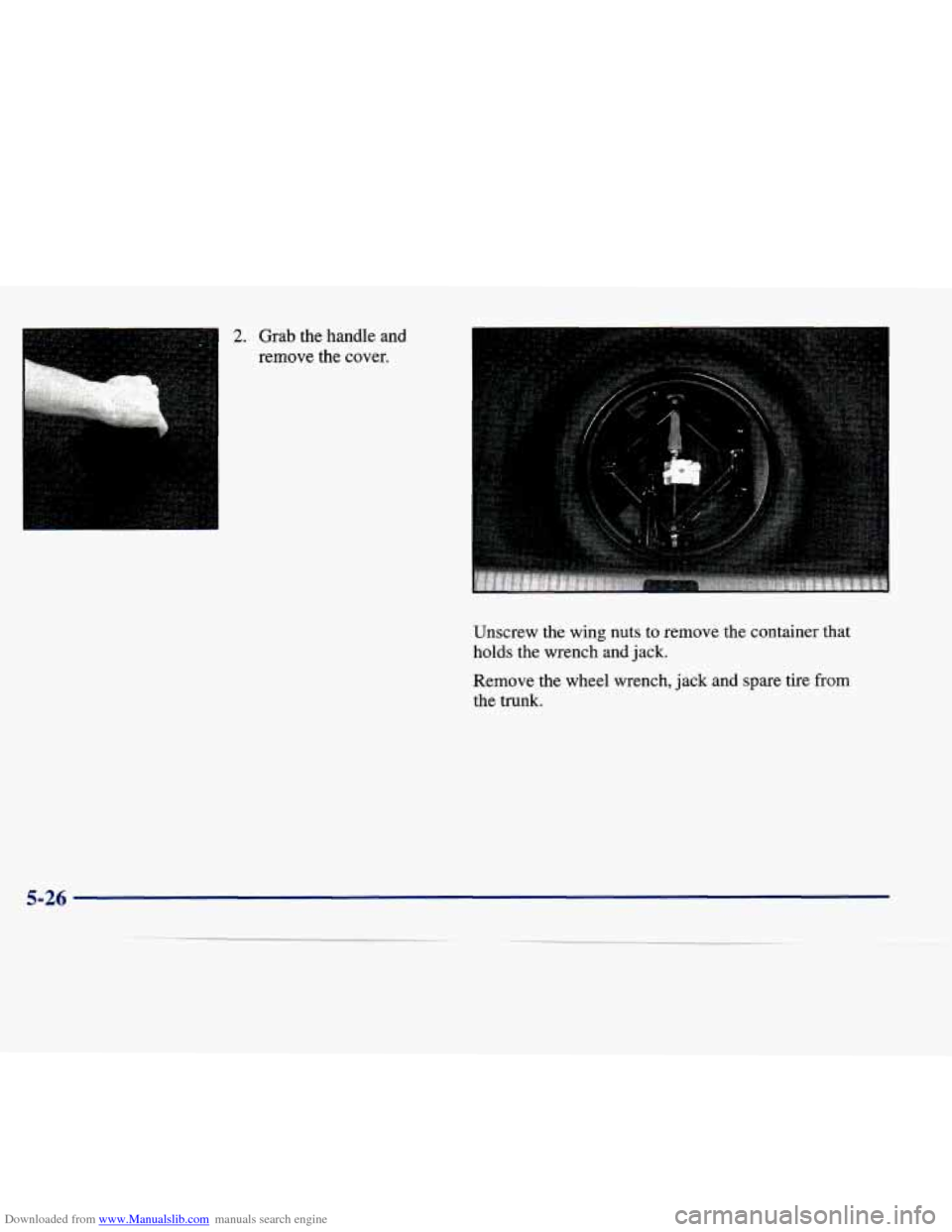
Downloaded from www.Manualslib.com manuals search engine I 2. Grab the handle and
remove the cover.
Unscrew the wing nuts
to remove the container that
holds the wrench and jack.
Remove the wheel wrench, jack and spare tire from
the trunk.
5-26
Page 265 of 378
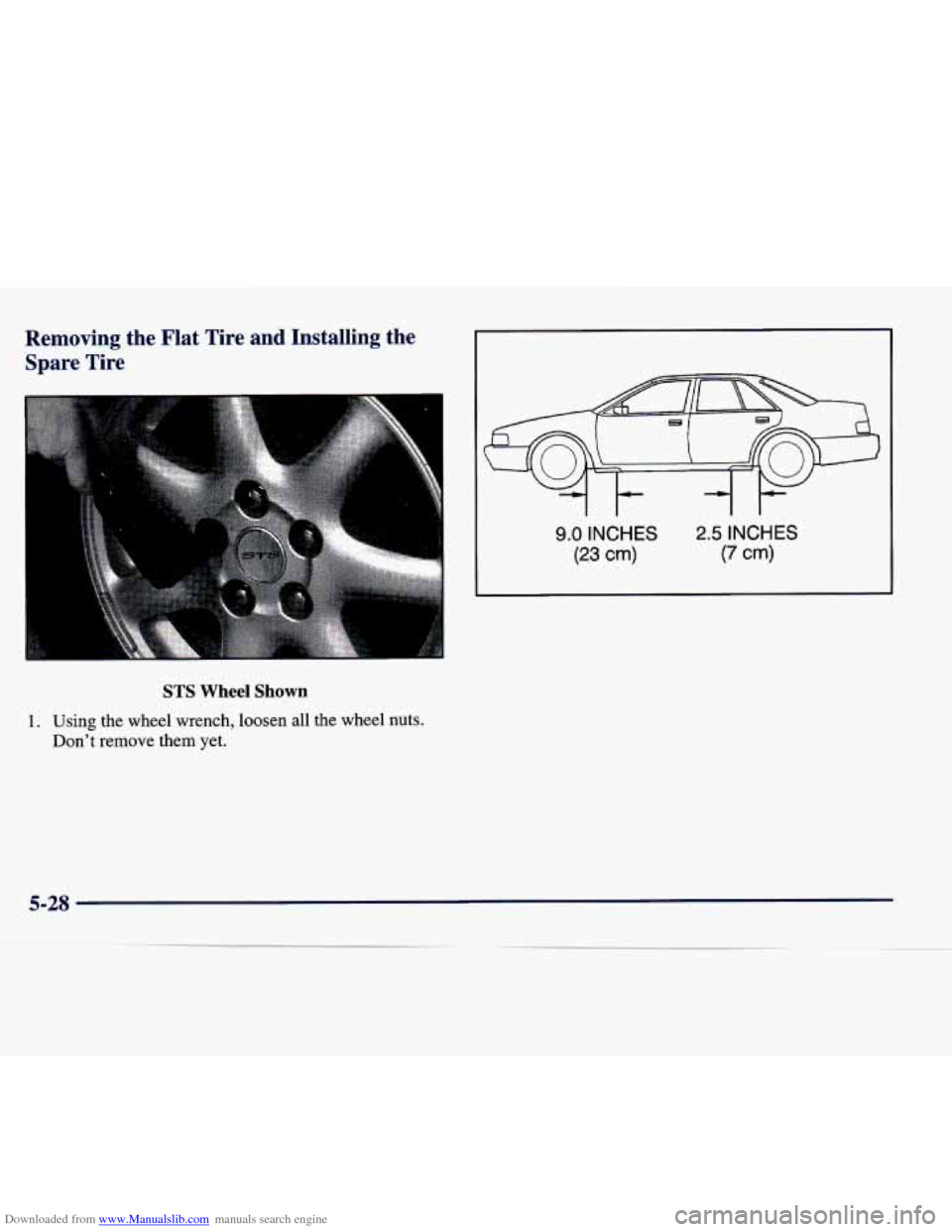
Downloaded from www.Manualslib.com manuals search engine Removing the Flat Tire and Installing the Spare Tire
9.0 INCHES
(23 cm)
2.5 INCHES
(7 cm)
STS Wheel Shown
1. Using the wheel wrench, loosen all the wheel nuts.
Don’t remove them yet.
5-28
Page 267 of 378
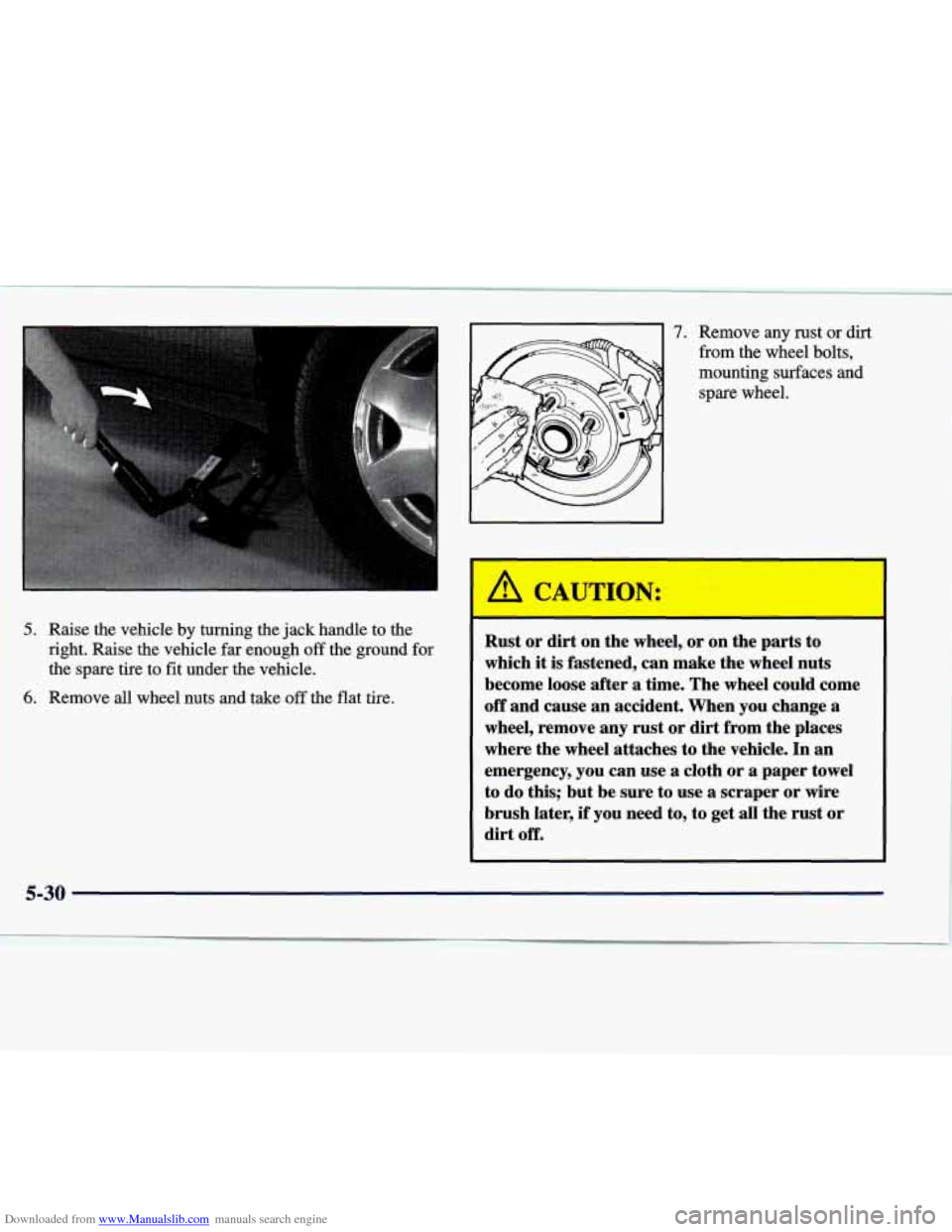
Downloaded from www.Manualslib.com manuals search engine 5. Raise the vehicle by turning the jack handle to the
right. Raise the
vehicle far enough off the ground for
the spare tire to fit under the vehicle.
6. Remove all wheel nuts and take off the flat tire.
1.
~
~~ ~ ~~
~ ~ ~~
Remove any rust or dirt
from the wheel bolts,
mounting surfaces and
spare wheel.
Rust or dirt on the wheel, or on the parts to
which it
is fastened, can make the wheel nuts
become loose after
a time. The wheel could come
off and cause an accident. When you change a
wheel, remove any rust or dirt from the places
where the wheel attaches to the vehicle.
In an
emergency, you can use a cloth or
a paper towel
to do this; but be sure to use a scraper or wire
brush later, if you need to, to get all the rust or
dirt off.
5-30
Page 270 of 378
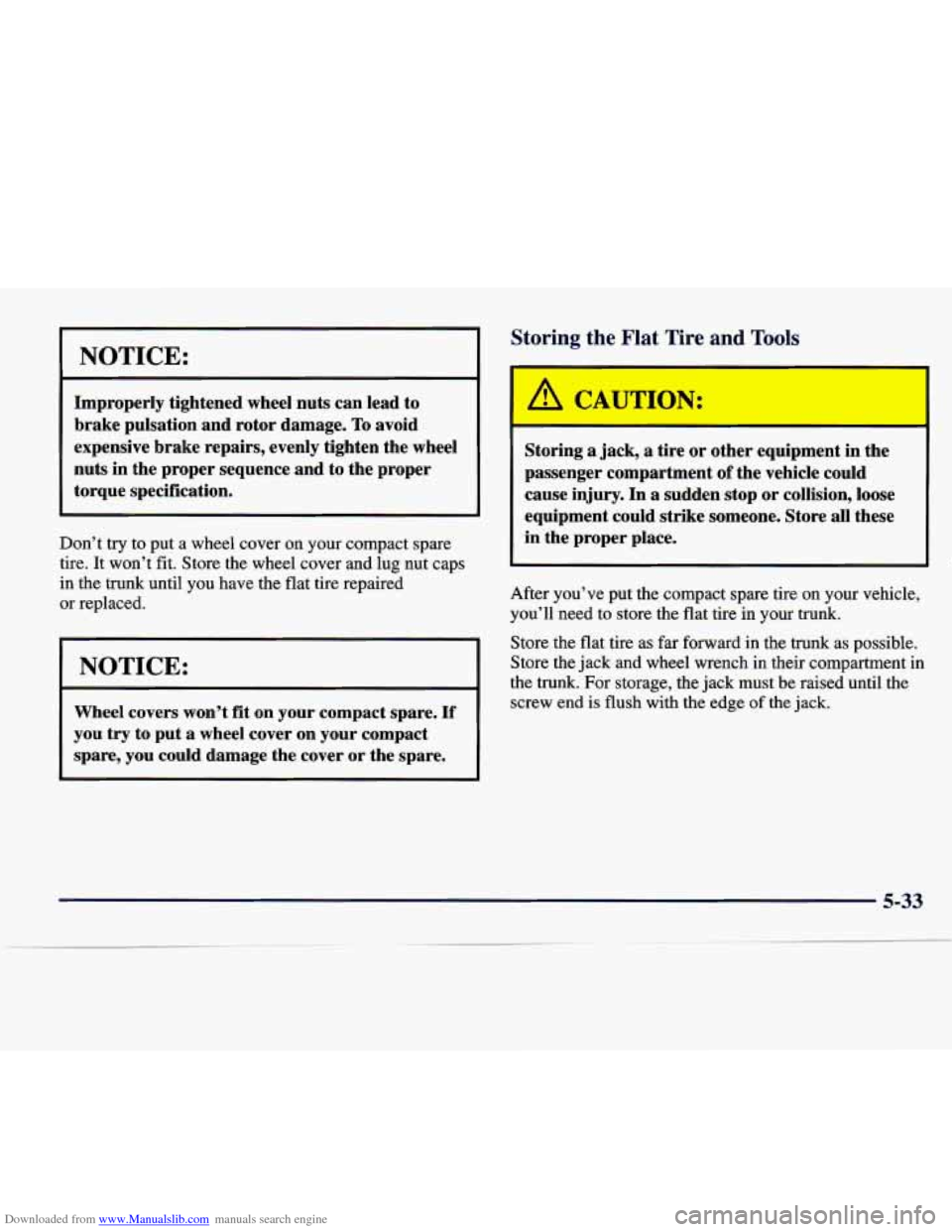
Downloaded from www.Manualslib.com manuals search engine NOTICE:
Improperly tightened wheel nuts can lead to
brake pulsation and rotor damage.
To avoid
expensive brake repairs, evenly tighten the wheel
nuts in the proper sequence and to the proper
torque specification.
Don’t try to put a wheel cover on your compact spare
tire.
It won’t fit. Store the wheel cover and lug nut caps
in the trunk until you have the flat tire repaired
or replaced.
I NOTICE:
Wheel covers won’t fit on your compact. spare. If
you try to put a wheel cover on your compact
spare, you could damage the cover or the spare.
Storing the Flat Tire and Tools
,A CAUTION:
Storing a jack, a tire or other equipment in the
passenger compartment
of the vehicle could
cause injury. In
a sudden stop or collision, loose
equipment could strike someone. Store all these
in the proper place.
After you’ve put the compact spare tire on your vehicle,
you’ll need to store the flat tire in your trunk.
Store the flat tire as far forward in the trunk as possible.
Store the jack and wheel wrench in their compartment in
the trunk. For storage, the
jack must be raised until the
screw end is flush with the edge of the jack.
5-33
.~ .~
Page 272 of 378
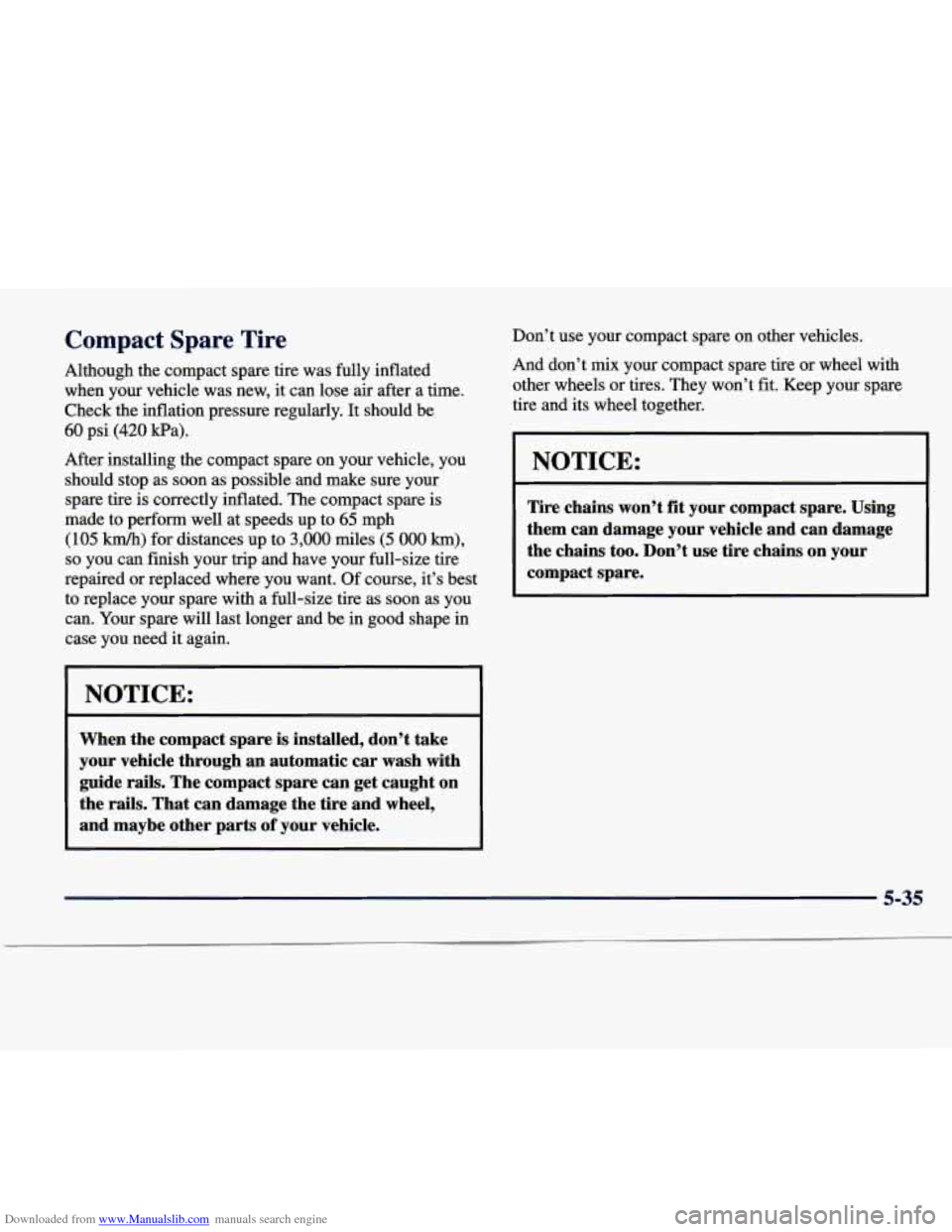
Downloaded from www.Manualslib.com manuals search engine Compact Span re
Although the compact spare tire was fully inflated
when your vehicle was new, it can lose air after a time.
Check the inflation pressure regularly. It should be
60 psi (420 Wa).
After installing the compact spare on your vehicle, you should stop as soon as possible and make sure your
spare tire
is correctly inflated. The compact spare is
made to perform well at speeds up to
65 mph
(105 kndh) for distances up to 3,000 miles (5 000 km),
so you can finish your trip and have your full-size tire
repaired or replaced where you want. Of course, it’s best
to replace your spare with a full-size
tire as soon as you
can. Your spare will last longer and be in good shape in
case
you need it again.
NOTICE:
When the compact spare is installed, don’t take
your vehicle through an automatic car wash with
guide rails. The compact spare can get caught on
the rails. That can damage the tire and wheel,
and maybe other parts
of your vehicle.
Don’t use your compact spare on other vehicles.
And don’t
mix your compact spare tire or wheel with
other wheels or tires. They won’t fit. Keep your spare tire and its wheel together.
NOTICE:
Tire chains won’t fit your compact spare. Using
them can damage your vehicle and can damage
the chains too. Don’t use tire chains on your
compact spare.
Page 319 of 378
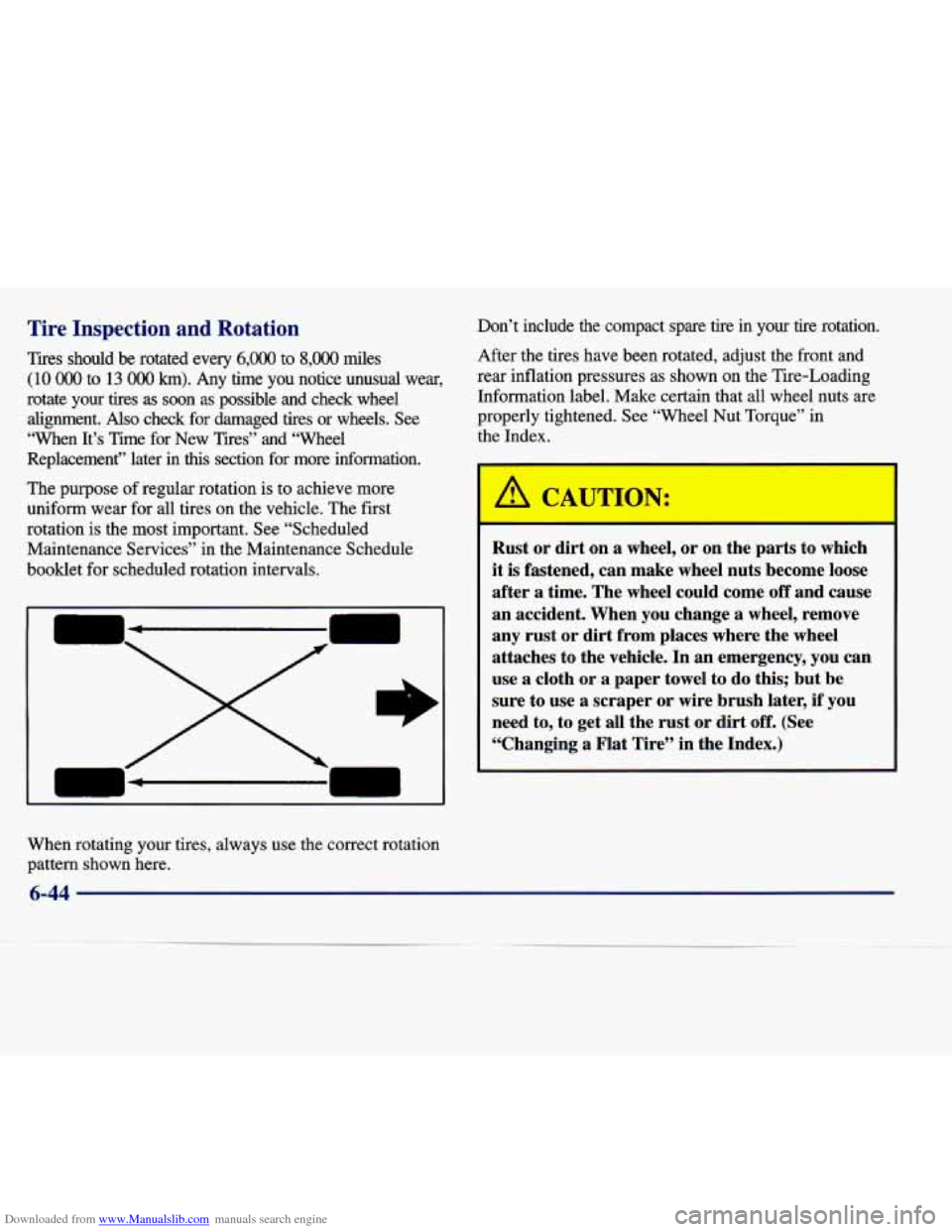
Downloaded from www.Manualslib.com manuals search engine Tire Inspection and Rotation
Tires should be rotated every 6,000 to S,O00 miles
(10 000 to 13 OOO km). Any time you notice unusual wear,
rotate
your tires as soon as possible and check wheel
alignment.
Also check for damaged tires or wheels. See
“When It’s Time for New Tires” and “Wheel
Replacement” later in
this section for more information.
The purpose of regular rotation is to achieve more
uniform wear for all tires on the vehicle. The first
rotation is the most important. See “Scheduled
Maintenance Services” in the Maintenance Schedule
booklet
for scheduled rotation intervals.
When rotating
your tires, always use the correct rotation
pattern shown here. Don’t include the compact spare tire in
your tire rotation.
After the tires have been rotated, adjust the front and
rear inflation pressures as shown on the Tire-Loading Information label. Make certain that all wheel nuts are
properly tightened. See “Wheel Nut Torque” in
the Index.
I
Rust or dirt on a wheel, or on the parts to which
it is fastened, can make wheel nuts become loose
after a time. The wheel could come
off and cause
an accident. When you change
a wheel, remove
any rust or dirt from places where the wheel
attaches to the vehicle. In an emergency, you can
use a cloth or
a paper towel to do this; but be
sure to use
a scraper or wire brush later, if you
need to, to get all the rust or dirt
off. (See
“Changing
a Flat Tire” in the Index.)
1
6-44
Page 321 of 378
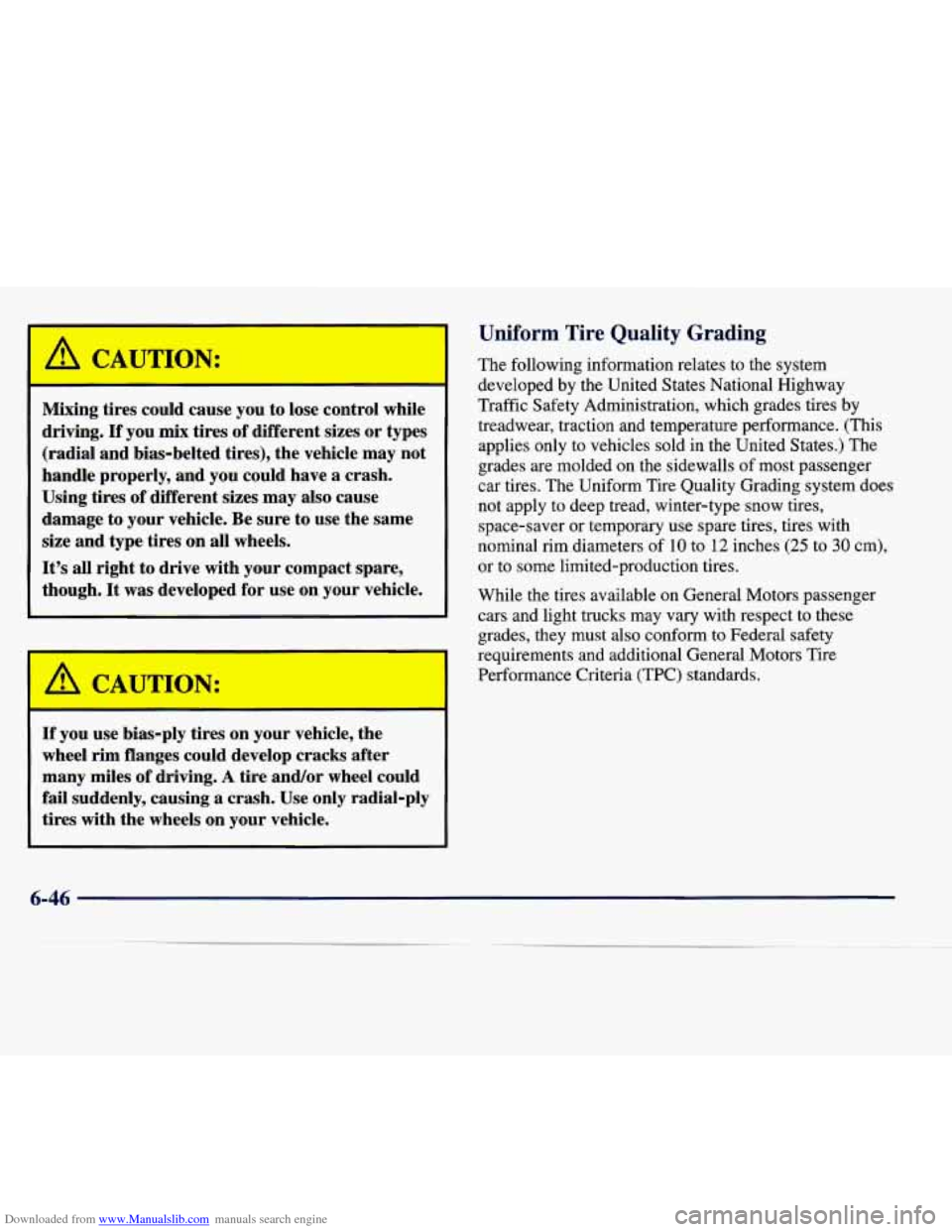
Downloaded from www.Manualslib.com manuals search engine A CAUTIL I:
Mixing tires could cause you to lose control while
driving.
If you mix tires of different sizes or types
(radial and bias-belted tires), the vehicle may not
handle properly, and you could have
a crash.
Using tires of different sizes may also cause
damage to your vehicle. Be sure to use the same
size and type tires on all wheels.
It’s all right to drive with your compact spare,
though.
It was developed for use on your vehicle.
I A CAUTION:
If you use bias-ply tires on your vehicle, the
wheel rim flanges could develop cracks after
many miles
of driving. A tire and/or wheel could
fail suddenly, causing
a crash. Use only radial-ply
tires with the wheels on your vehicle.
Uniform Tire Quality Grading
The following information relates to the system
developed by the United States National Highway
Traffic Safety Administration, which grades tires by
treadwear, traction and temperature performance. (This applies only to vehicles sold in the United States.) The
grades are molded on
the sidewalls of most passenger
car tires. The Uniform Tire Quality Grading system does
not apply to deep tread, winter-type snow tires,
space-saver or temporary use spare tires, tires with
nominal rim diameters of
10 to 12 inches (25 to 30 cm),
or to some limited-production tires.
While the tires available on General Motors passenger
cars and light trucks may vary with respect to these
grades, they must also conform to Federal safety
requirements and additional General Motors Tire
Performance Criteria (TPC) standards.
6-46
Page 364 of 378
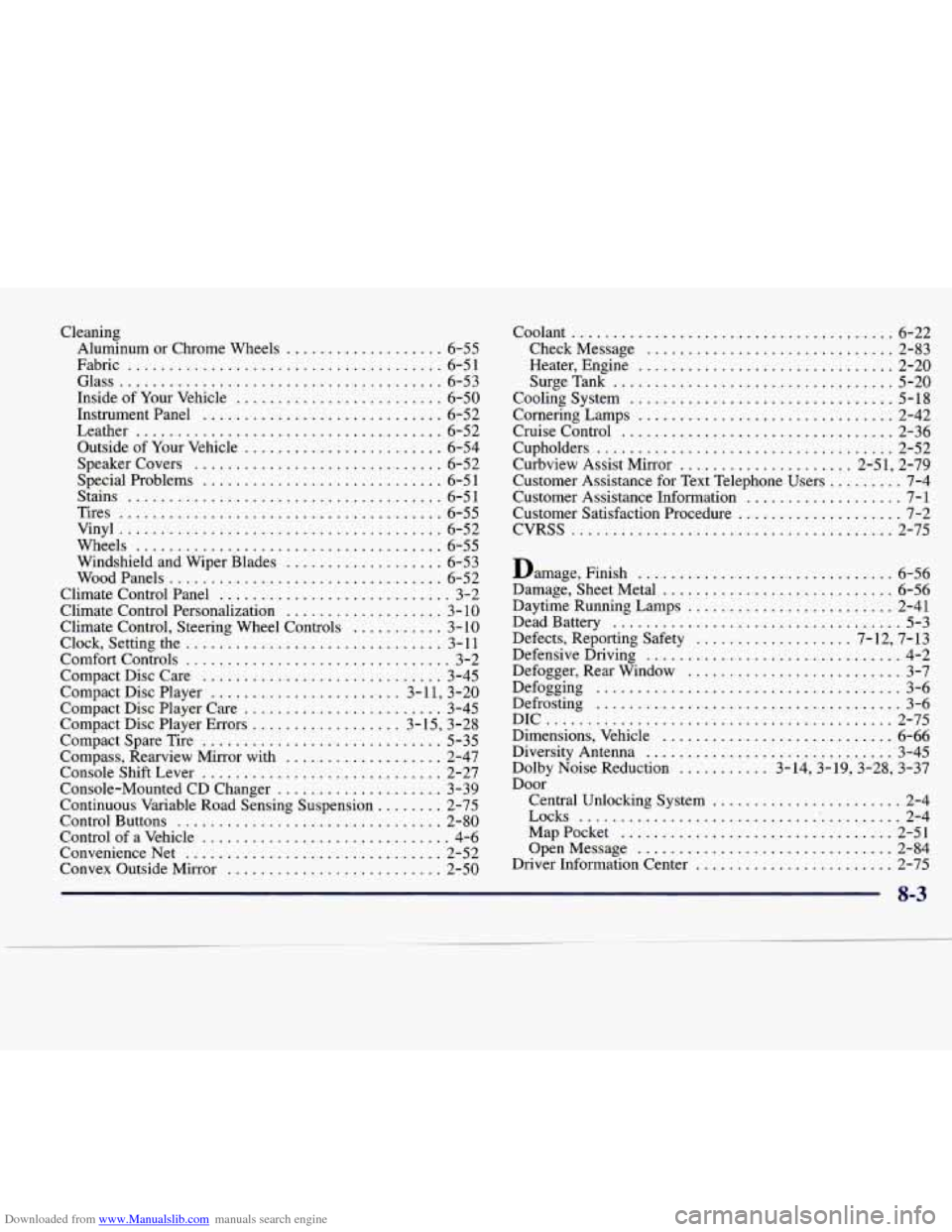
Downloaded from www.Manualslib.com manuals search engine Cleaning Aluminum or Chrome Wheels
................... 6-55
Fabric
...................................... 6-51
Glass
....................................... 6-53
Inside of Your Vehicle
......................... 6-50
Instrument Panel
............................. 6-52
Leather
..................................... 6-52
Outside of Your Vehicle
........................ 6-54
Speakercovers
.............................. 6-52
Special Problems
............................. 6-5 1
Stains ...................................... 6-5 1
Tires
....................................... 6-55
Vinyl
....................................... 6-52
Wheels
..................................... 6-55
Windshield and Wiper Blades
................... 6-53
WoodPanels
................................. 6-52
Climate Control Panel
............................ 3-2
Climate Control Personalization
................... 3- 10
Climate Control. Steering Wheel Controls ........... 3-10
Clock. Setting the ............................... 3- 11
Comfort Controls ................................ 3-2
Compact Disc Care
............................. 3-45
Compact Disc Player
....................... 3-1 1. 3-20
Compact Disc Player Care
........................ 3-45
Compact Disc Player Errors
.................. 3-15. 3-28
Compact Spare Tire
............................. 5-35
Compass. Rearview Mirror with
................... 2-47
Console Shift Lever
............................. 2-27
Console-Mounted CD Changer
.................... 3-39
Continuous Variable Road Sensing Suspension
........ 2-75
Control Buttons
................................ 2-80
Control of a Vehicle
.............................. 4-6
ConvenienceNet
............................... 2-52
Convex Outside Mirror
.......................... 2-50 Coolant
....................................... 6-22
CheckMessage
.............................. 2-83
Heater. Engine
............................... 2-20
SurgeTank
.................................. 5-20
Cooling System
................................ 5-18
Cornering Lamps
............................... 2-42
Cruise Control
................................. 2-36
Cupholders
.................................... 2-52
Curbview Assist Mirror
..................... 2.51. 2.79
Customer Assistance Information
................... 7-1
Customer Satisfaction Procedure
.................... 7-2
CVRSS
....................................... 2-75
Customer Assistance for
Text Telephone Users
......... 7-4
Damage. Finish
............................... 6-56
Damage. Sheet Metal
............................ 6-56
Daytime Running Lamps
......................... 2-41
Dead Battery
................................... 5-3
Defects. Reporting Safety
................... 7.12. 7.13
Defensive Driving
............................... 4-2
Defogger. Rear Window
.......................... 3-7
Defrosting
..................................... 3-6
DIC
.......................................... 2-75
Dimensions. Vehicle
............................ 6-66
Diversity Antenna
.............................. 3-45
Dolby Noise Reduction
........... 3.14.3.19.3.28. 3.37
Door Defogging
..................................... 3-6
Central Unlocking System
....................... 2-4
Locks
........................................ 2-4
MapPocket
................................. 2-51
OpenMessage
............................... 2-84
Driver Information Center
........................ 2-75
8-3